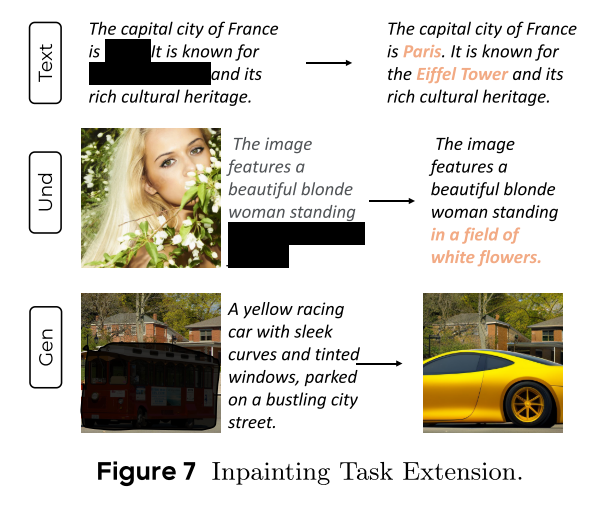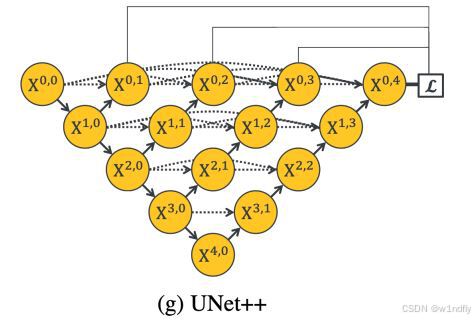基于Pytorch框架的深度学习U2Net网络天空语义精细分割系统源码
第一步:准备数据
头发分割数据,总共有10276张图片,里面的像素值为0和1,所以看起来全部是黑的,不影响使用

第二步:搭建模型
级联模式
通常多个类似U-Net按顺序堆叠,以建立级联模型,并可归纳为(Uxn-Net),n是重复U-Net模块的数目,带来的问题是计算和内存开销被n放大了。如DocUNet, CU-Net网络等,如下图所示,为DocUNet网络的构成:

U型嵌套模式
作者提出一种不同的U型结构叠加模型。我们的指数表示法是指嵌套的U型结构,而不是级联叠加。理论上,可以将指数n设为任意正整数,实现单级或多级嵌套U型结构。但是,嵌套层太多的体系结构过于复杂,无法在实际中实现和应用。
我们将n设为2来构建U2-Net,是一个两层嵌套的U型结构,如图5所示。它的顶层是一个由11 stages(图5中的立方体)组成的大U型结构,每一stage由一个配置良好的RSU填充。因此,嵌套的U结构可以更有效的提取stage内的多尺度特征和聚集阶段的多层次特征。

第三步:代码
1)损失函数为:交叉熵损失函数
2)网络代码:
import torch
import torch.nn as nn
from torchvision import models
import torch.nn.functional as Fclass REBNCONV(nn.Module):def __init__(self,in_ch=3,out_ch=3,dirate=1):super(REBNCONV,self).__init__()self.conv_s1 = nn.Conv2d(in_ch,out_ch,3,padding=1*dirate,dilation=1*dirate)self.bn_s1 = nn.BatchNorm2d(out_ch)self.relu_s1 = nn.ReLU(inplace=True)def forward(self,x):hx = xxout = self.relu_s1(self.bn_s1(self.conv_s1(hx)))return xout## upsample tensor 'src' to have the same spatial size with tensor 'tar'
def _upsample_like(src,tar):src = F.upsample(src,size=tar.shape[2:],mode='bilinear')return src### RSU-7 ###
class RSU7(nn.Module):#UNet07DRES(nn.Module):def __init__(self, in_ch=3, mid_ch=12, out_ch=3):super(RSU7,self).__init__()self.rebnconvin = REBNCONV(in_ch,out_ch,dirate=1)self.rebnconv1 = REBNCONV(out_ch,mid_ch,dirate=1)self.pool1 = nn.MaxPool2d(2,stride=2,ceil_mode=True)self.rebnconv2 = REBNCONV(mid_ch,mid_ch,dirate=1)self.pool2 = nn.MaxPool2d(2,stride=2,ceil_mode=True)self.rebnconv3 = REBNCONV(mid_ch,mid_ch,dirate=1)self.pool3 = nn.MaxPool2d(2,stride=2,ceil_mode=True)self.rebnconv4 = REBNCONV(mid_ch,mid_ch,dirate=1)self.pool4 = nn.MaxPool2d(2,stride=2,ceil_mode=True)self.rebnconv5 = REBNCONV(mid_ch,mid_ch,dirate=1)self.pool5 = nn.MaxPool2d(2,stride=2,ceil_mode=True)self.rebnconv6 = REBNCONV(mid_ch,mid_ch,dirate=1)self.rebnconv7 = REBNCONV(mid_ch,mid_ch,dirate=2)self.rebnconv6d = REBNCONV(mid_ch*2,mid_ch,dirate=1)self.rebnconv5d = REBNCONV(mid_ch*2,mid_ch,dirate=1)self.rebnconv4d = REBNCONV(mid_ch*2,mid_ch,dirate=1)self.rebnconv3d = REBNCONV(mid_ch*2,mid_ch,dirate=1)self.rebnconv2d = REBNCONV(mid_ch*2,mid_ch,dirate=1)self.rebnconv1d = REBNCONV(mid_ch*2,out_ch,dirate=1)def forward(self,x):hx = xhxin = self.rebnconvin(hx)hx1 = self.rebnconv1(hxin)hx = self.pool1(hx1)hx2 = self.rebnconv2(hx)hx = self.pool2(hx2)hx3 = self.rebnconv3(hx)hx = self.pool3(hx3)hx4 = self.rebnconv4(hx)hx = self.pool4(hx4)hx5 = self.rebnconv5(hx)hx = self.pool5(hx5)hx6 = self.rebnconv6(hx)hx7 = self.rebnconv7(hx6)hx6d = self.rebnconv6d(torch.cat((hx7,hx6),1))hx6dup = _upsample_like(hx6d,hx5)hx5d = self.rebnconv5d(torch.cat((hx6dup,hx5),1))hx5dup = _upsample_like(hx5d,hx4)hx4d = self.rebnconv4d(torch.cat((hx5dup,hx4),1))hx4dup = _upsample_like(hx4d,hx3)hx3d = self.rebnconv3d(torch.cat((hx4dup,hx3),1))hx3dup = _upsample_like(hx3d,hx2)hx2d = self.rebnconv2d(torch.cat((hx3dup,hx2),1))hx2dup = _upsample_like(hx2d,hx1)hx1d = self.rebnconv1d(torch.cat((hx2dup,hx1),1))return hx1d + hxin### RSU-6 ###
class RSU6(nn.Module):#UNet06DRES(nn.Module):def __init__(self, in_ch=3, mid_ch=12, out_ch=3):super(RSU6,self).__init__()self.rebnconvin = REBNCONV(in_ch,out_ch,dirate=1)self.rebnconv1 = REBNCONV(out_ch,mid_ch,dirate=1)self.pool1 = nn.MaxPool2d(2,stride=2,ceil_mode=True)self.rebnconv2 = REBNCONV(mid_ch,mid_ch,dirate=1)self.pool2 = nn.MaxPool2d(2,stride=2,ceil_mode=True)self.rebnconv3 = REBNCONV(mid_ch,mid_ch,dirate=1)self.pool3 = nn.MaxPool2d(2,stride=2,ceil_mode=True)self.rebnconv4 = REBNCONV(mid_ch,mid_ch,dirate=1)self.pool4 = nn.MaxPool2d(2,stride=2,ceil_mode=True)self.rebnconv5 = REBNCONV(mid_ch,mid_ch,dirate=1)self.rebnconv6 = REBNCONV(mid_ch,mid_ch,dirate=2)self.rebnconv5d = REBNCONV(mid_ch*2,mid_ch,dirate=1)self.rebnconv4d = REBNCONV(mid_ch*2,mid_ch,dirate=1)self.rebnconv3d = REBNCONV(mid_ch*2,mid_ch,dirate=1)self.rebnconv2d = REBNCONV(mid_ch*2,mid_ch,dirate=1)self.rebnconv1d = REBNCONV(mid_ch*2,out_ch,dirate=1)def forward(self,x):hx = xhxin = self.rebnconvin(hx)hx1 = self.rebnconv1(hxin)hx = self.pool1(hx1)hx2 = self.rebnconv2(hx)hx = self.pool2(hx2)hx3 = self.rebnconv3(hx)hx = self.pool3(hx3)hx4 = self.rebnconv4(hx)hx = self.pool4(hx4)hx5 = self.rebnconv5(hx)hx6 = self.rebnconv6(hx5)hx5d = self.rebnconv5d(torch.cat((hx6,hx5),1))hx5dup = _upsample_like(hx5d,hx4)hx4d = self.rebnconv4d(torch.cat((hx5dup,hx4),1))hx4dup = _upsample_like(hx4d,hx3)hx3d = self.rebnconv3d(torch.cat((hx4dup,hx3),1))hx3dup = _upsample_like(hx3d,hx2)hx2d = self.rebnconv2d(torch.cat((hx3dup,hx2),1))hx2dup = _upsample_like(hx2d,hx1)hx1d = self.rebnconv1d(torch.cat((hx2dup,hx1),1))return hx1d + hxin### RSU-5 ###
class RSU5(nn.Module):#UNet05DRES(nn.Module):def __init__(self, in_ch=3, mid_ch=12, out_ch=3):super(RSU5,self).__init__()self.rebnconvin = REBNCONV(in_ch,out_ch,dirate=1)self.rebnconv1 = REBNCONV(out_ch,mid_ch,dirate=1)self.pool1 = nn.MaxPool2d(2,stride=2,ceil_mode=True)self.rebnconv2 = REBNCONV(mid_ch,mid_ch,dirate=1)self.pool2 = nn.MaxPool2d(2,stride=2,ceil_mode=True)self.rebnconv3 = REBNCONV(mid_ch,mid_ch,dirate=1)self.pool3 = nn.MaxPool2d(2,stride=2,ceil_mode=True)self.rebnconv4 = REBNCONV(mid_ch,mid_ch,dirate=1)self.rebnconv5 = REBNCONV(mid_ch,mid_ch,dirate=2)self.rebnconv4d = REBNCONV(mid_ch*2,mid_ch,dirate=1)self.rebnconv3d = REBNCONV(mid_ch*2,mid_ch,dirate=1)self.rebnconv2d = REBNCONV(mid_ch*2,mid_ch,dirate=1)self.rebnconv1d = REBNCONV(mid_ch*2,out_ch,dirate=1)def forward(self,x):hx = xhxin = self.rebnconvin(hx)hx1 = self.rebnconv1(hxin)hx = self.pool1(hx1)hx2 = self.rebnconv2(hx)hx = self.pool2(hx2)hx3 = self.rebnconv3(hx)hx = self.pool3(hx3)hx4 = self.rebnconv4(hx)hx5 = self.rebnconv5(hx4)hx4d = self.rebnconv4d(torch.cat((hx5,hx4),1))hx4dup = _upsample_like(hx4d,hx3)hx3d = self.rebnconv3d(torch.cat((hx4dup,hx3),1))hx3dup = _upsample_like(hx3d,hx2)hx2d = self.rebnconv2d(torch.cat((hx3dup,hx2),1))hx2dup = _upsample_like(hx2d,hx1)hx1d = self.rebnconv1d(torch.cat((hx2dup,hx1),1))return hx1d + hxin### RSU-4 ###
class RSU4(nn.Module):#UNet04DRES(nn.Module):def __init__(self, in_ch=3, mid_ch=12, out_ch=3):super(RSU4,self).__init__()self.rebnconvin = REBNCONV(in_ch,out_ch,dirate=1)self.rebnconv1 = REBNCONV(out_ch,mid_ch,dirate=1)self.pool1 = nn.MaxPool2d(2,stride=2,ceil_mode=True)self.rebnconv2 = REBNCONV(mid_ch,mid_ch,dirate=1)self.pool2 = nn.MaxPool2d(2,stride=2,ceil_mode=True)self.rebnconv3 = REBNCONV(mid_ch,mid_ch,dirate=1)self.rebnconv4 = REBNCONV(mid_ch,mid_ch,dirate=2)self.rebnconv3d = REBNCONV(mid_ch*2,mid_ch,dirate=1)self.rebnconv2d = REBNCONV(mid_ch*2,mid_ch,dirate=1)self.rebnconv1d = REBNCONV(mid_ch*2,out_ch,dirate=1)def forward(self,x):hx = xhxin = self.rebnconvin(hx)hx1 = self.rebnconv1(hxin)hx = self.pool1(hx1)hx2 = self.rebnconv2(hx)hx = self.pool2(hx2)hx3 = self.rebnconv3(hx)hx4 = self.rebnconv4(hx3)hx3d = self.rebnconv3d(torch.cat((hx4,hx3),1))hx3dup = _upsample_like(hx3d,hx2)hx2d = self.rebnconv2d(torch.cat((hx3dup,hx2),1))hx2dup = _upsample_like(hx2d,hx1)hx1d = self.rebnconv1d(torch.cat((hx2dup,hx1),1))return hx1d + hxin### RSU-4F ###
class RSU4F(nn.Module):#UNet04FRES(nn.Module):def __init__(self, in_ch=3, mid_ch=12, out_ch=3):super(RSU4F,self).__init__()self.rebnconvin = REBNCONV(in_ch,out_ch,dirate=1)self.rebnconv1 = REBNCONV(out_ch,mid_ch,dirate=1)self.rebnconv2 = REBNCONV(mid_ch,mid_ch,dirate=2)self.rebnconv3 = REBNCONV(mid_ch,mid_ch,dirate=4)self.rebnconv4 = REBNCONV(mid_ch,mid_ch,dirate=8)self.rebnconv3d = REBNCONV(mid_ch*2,mid_ch,dirate=4)self.rebnconv2d = REBNCONV(mid_ch*2,mid_ch,dirate=2)self.rebnconv1d = REBNCONV(mid_ch*2,out_ch,dirate=1)def forward(self,x):hx = xhxin = self.rebnconvin(hx)hx1 = self.rebnconv1(hxin)hx2 = self.rebnconv2(hx1)hx3 = self.rebnconv3(hx2)hx4 = self.rebnconv4(hx3)hx3d = self.rebnconv3d(torch.cat((hx4,hx3),1))hx2d = self.rebnconv2d(torch.cat((hx3d,hx2),1))hx1d = self.rebnconv1d(torch.cat((hx2d,hx1),1))return hx1d + hxin##### U^2-Net ####
class U2NET(nn.Module):def __init__(self,in_ch=3,out_ch=1):super(U2NET,self).__init__()self.stage1 = RSU7(in_ch,32,64)self.pool12 = nn.MaxPool2d(2,stride=2,ceil_mode=True)self.stage2 = RSU6(64,32,128)self.pool23 = nn.MaxPool2d(2,stride=2,ceil_mode=True)self.stage3 = RSU5(128,64,256)self.pool34 = nn.MaxPool2d(2,stride=2,ceil_mode=True)self.stage4 = RSU4(256,128,512)self.pool45 = nn.MaxPool2d(2,stride=2,ceil_mode=True)self.stage5 = RSU4F(512,256,512)self.pool56 = nn.MaxPool2d(2,stride=2,ceil_mode=True)self.stage6 = RSU4F(512,256,512)# decoderself.stage5d = RSU4F(1024,256,512)self.stage4d = RSU4(1024,128,256)self.stage3d = RSU5(512,64,128)self.stage2d = RSU6(256,32,64)self.stage1d = RSU7(128,16,64)self.side1 = nn.Conv2d(64,out_ch,3,padding=1)self.side2 = nn.Conv2d(64,out_ch,3,padding=1)self.side3 = nn.Conv2d(128,out_ch,3,padding=1)self.side4 = nn.Conv2d(256,out_ch,3,padding=1)self.side5 = nn.Conv2d(512,out_ch,3,padding=1)self.side6 = nn.Conv2d(512,out_ch,3,padding=1)self.outconv = nn.Conv2d(6,out_ch,1)def forward(self,x):hx = x#stage 1hx1 = self.stage1(hx)hx = self.pool12(hx1)#stage 2hx2 = self.stage2(hx)hx = self.pool23(hx2)#stage 3hx3 = self.stage3(hx)hx = self.pool34(hx3)#stage 4hx4 = self.stage4(hx)hx = self.pool45(hx4)#stage 5hx5 = self.stage5(hx)hx = self.pool56(hx5)#stage 6hx6 = self.stage6(hx)hx6up = _upsample_like(hx6,hx5)#-------------------- decoder --------------------hx5d = self.stage5d(torch.cat((hx6up,hx5),1))hx5dup = _upsample_like(hx5d,hx4)hx4d = self.stage4d(torch.cat((hx5dup,hx4),1))hx4dup = _upsample_like(hx4d,hx3)hx3d = self.stage3d(torch.cat((hx4dup,hx3),1))hx3dup = _upsample_like(hx3d,hx2)hx2d = self.stage2d(torch.cat((hx3dup,hx2),1))hx2dup = _upsample_like(hx2d,hx1)hx1d = self.stage1d(torch.cat((hx2dup,hx1),1))#side outputd1 = self.side1(hx1d)d2 = self.side2(hx2d)d2 = _upsample_like(d2,d1)d3 = self.side3(hx3d)d3 = _upsample_like(d3,d1)d4 = self.side4(hx4d)d4 = _upsample_like(d4,d1)d5 = self.side5(hx5d)d5 = _upsample_like(d5,d1)d6 = self.side6(hx6)d6 = _upsample_like(d6,d1)d0 = self.outconv(torch.cat((d1,d2,d3,d4,d5,d6),1))#return F.sigmoid(d0), F.sigmoid(d1), F.sigmoid(d2), F.sigmoid(d3), F.sigmoid(d4), F.sigmoid(d5), F.sigmoid(d6)return d0, d1, d2, d3, d4, d5, d6class U2NET_half(nn.Module):def __init__(self,in_ch=3,out_ch=1):super(U2NET_half,self).__init__()self.stage1 = RSU7(in_ch,16,32)self.pool12 = nn.MaxPool2d(2,stride=2,ceil_mode=True)self.stage2 = RSU6(32,16,64)self.pool23 = nn.MaxPool2d(2,stride=2,ceil_mode=True)self.stage3 = RSU5(64,32,128)self.pool34 = nn.MaxPool2d(2,stride=2,ceil_mode=True)self.stage4 = RSU4(128,64,256)self.pool45 = nn.MaxPool2d(2,stride=2,ceil_mode=True)self.stage5 = RSU4F(256,128,256)self.pool56 = nn.MaxPool2d(2,stride=2,ceil_mode=True)self.stage6 = RSU4F(256,128,256)# decoderself.stage5d = RSU4F(512,128,256)self.stage4d = RSU4(512,64,128)self.stage3d = RSU5(256,32,64)self.stage2d = RSU6(128,16,32)self.stage1d = RSU7(64,8,32)self.side1 = nn.Conv2d(32,out_ch,3,padding=1)self.side2 = nn.Conv2d(32,out_ch,3,padding=1)self.side3 = nn.Conv2d(64,out_ch,3,padding=1)self.side4 = nn.Conv2d(128,out_ch,3,padding=1)self.side5 = nn.Conv2d(256,out_ch,3,padding=1)self.side6 = nn.Conv2d(256,out_ch,3,padding=1)self.outconv = nn.Conv2d(6,out_ch,1)def forward(self,x):hx = x#stage 1hx1 = self.stage1(hx)hx = self.pool12(hx1)#stage 2hx2 = self.stage2(hx)hx = self.pool23(hx2)#stage 3hx3 = self.stage3(hx)hx = self.pool34(hx3)#stage 4hx4 = self.stage4(hx)hx = self.pool45(hx4)#stage 5hx5 = self.stage5(hx)hx = self.pool56(hx5)#stage 6hx6 = self.stage6(hx)hx6up = _upsample_like(hx6,hx5)#-------------------- decoder --------------------hx5d = self.stage5d(torch.cat((hx6up,hx5),1))hx5dup = _upsample_like(hx5d,hx4)hx4d = self.stage4d(torch.cat((hx5dup,hx4),1))hx4dup = _upsample_like(hx4d,hx3)hx3d = self.stage3d(torch.cat((hx4dup,hx3),1))hx3dup = _upsample_like(hx3d,hx2)hx2d = self.stage2d(torch.cat((hx3dup,hx2),1))hx2dup = _upsample_like(hx2d,hx1)hx1d = self.stage1d(torch.cat((hx2dup,hx1),1))#side outputd1 = self.side1(hx1d)d2 = self.side2(hx2d)d2 = _upsample_like(d2,d1)d3 = self.side3(hx3d)d3 = _upsample_like(d3,d1)d4 = self.side4(hx4d)d4 = _upsample_like(d4,d1)d5 = self.side5(hx5d)d5 = _upsample_like(d5,d1)d6 = self.side6(hx6)d6 = _upsample_like(d6,d1)d0 = self.outconv(torch.cat((d1,d2,d3,d4,d5,d6),1))#return F.sigmoid(d0), F.sigmoid(d1), F.sigmoid(d2), F.sigmoid(d3), F.sigmoid(d4), F.sigmoid(d5), F.sigmoid(d6)return d0, d1, d2, d3, d4, d5, d6### U^2-Net small ###
class U2NETP(nn.Module):def __init__(self,in_ch=3,out_ch=1):super(U2NETP,self).__init__()self.stage1 = RSU7(in_ch,16,64)self.pool12 = nn.MaxPool2d(2,stride=2,ceil_mode=True)self.stage2 = RSU6(64,16,64)self.pool23 = nn.MaxPool2d(2,stride=2,ceil_mode=True)self.stage3 = RSU5(64,16,64)self.pool34 = nn.MaxPool2d(2,stride=2,ceil_mode=True)self.stage4 = RSU4(64,16,64)self.pool45 = nn.MaxPool2d(2,stride=2,ceil_mode=True)self.stage5 = RSU4F(64,16,64)self.pool56 = nn.MaxPool2d(2,stride=2,ceil_mode=True)self.stage6 = RSU4F(64,16,64)# decoderself.stage5d = RSU4F(128,16,64)self.stage4d = RSU4(128,16,64)self.stage3d = RSU5(128,16,64)self.stage2d = RSU6(128,16,64)self.stage1d = RSU7(128,16,64)self.side1 = nn.Conv2d(64,out_ch,3,padding=1)self.side2 = nn.Conv2d(64,out_ch,3,padding=1)self.side3 = nn.Conv2d(64,out_ch,3,padding=1)self.side4 = nn.Conv2d(64,out_ch,3,padding=1)self.side5 = nn.Conv2d(64,out_ch,3,padding=1)self.side6 = nn.Conv2d(64,out_ch,3,padding=1)self.outconv = nn.Conv2d(6,out_ch,1)def forward(self,x):hx = x#stage 1hx1 = self.stage1(hx)hx = self.pool12(hx1)#stage 2hx2 = self.stage2(hx)hx = self.pool23(hx2)#stage 3hx3 = self.stage3(hx)hx = self.pool34(hx3)#stage 4hx4 = self.stage4(hx)hx = self.pool45(hx4)#stage 5hx5 = self.stage5(hx)hx = self.pool56(hx5)#stage 6hx6 = self.stage6(hx)hx6up = _upsample_like(hx6,hx5)#decoderhx5d = self.stage5d(torch.cat((hx6up,hx5),1))hx5dup = _upsample_like(hx5d,hx4)hx4d = self.stage4d(torch.cat((hx5dup,hx4),1))hx4dup = _upsample_like(hx4d,hx3)hx3d = self.stage3d(torch.cat((hx4dup,hx3),1))hx3dup = _upsample_like(hx3d,hx2)hx2d = self.stage2d(torch.cat((hx3dup,hx2),1))hx2dup = _upsample_like(hx2d,hx1)hx1d = self.stage1d(torch.cat((hx2dup,hx1),1))#side outputd1 = self.side1(hx1d)d2 = self.side2(hx2d)d2 = _upsample_like(d2,d1)d3 = self.side3(hx3d)d3 = _upsample_like(d3,d1)d4 = self.side4(hx4d)d4 = _upsample_like(d4,d1)d5 = self.side5(hx5d)d5 = _upsample_like(d5,d1)d6 = self.side6(hx6)d6 = _upsample_like(d6,d1)d0 = self.outconv(torch.cat((d1,d2,d3,d4,d5,d6),1))# return F.sigmoid(d0), F.sigmoid(d1), F.sigmoid(d2), F.sigmoid(d3), F.sigmoid(d4), F.sigmoid(d5), F.sigmoid(d6)return d0, d1, d2, d3, d4, d5, d6
第四步:搭建GUI界面



第五步:整个工程的内容
有训练代码和训练好的模型以及训练过程,提供数据,提供GUI界面代码
代码见:基于Pytorch框架的深度学习U2Net网络天空语义精细分割系统源码

有问题可以私信或者留言,有问必答

相关文章:

基于Pytorch框架的深度学习U2Net网络天空语义精细分割系统源码
第一步:准备数据 头发分割数据,总共有10276张图片,里面的像素值为0和1,所以看起来全部是黑的,不影响使用 第二步:搭建模型 级联模式 通常多个类似U-Net按顺序堆叠,以建立级联模型,…...

50ETF期权和股指期权有什么区别?ETF期权应该怎么做?
今天期权懂带你了解50ETF期权和股指期权有什么区别?ETF期权应该怎么做?ETF是对个股期权,股指期权是对应该股指期货的,那么股指期权和etf期权有什么区别? 股指期权怎么交易 股指期权交易要开通股指期货账户࿰…...

JS设计模式之“神奇的魔术师” - 简单工厂模式
引言 在JavaScript开发中,我们经常需要创建和管理各种对象,而简单工厂模式就是一种最简单的用来创建对象的设计模式。 简单工厂模式通过一个工厂类来创建相似的对象,而无需直接使用具体类来实例化对象。这样可以将对象的创建过程与使用过程…...

【河北航空-注册安全分析报告-无验证方式导致安全隐患】
前言 由于网站注册入口容易被黑客攻击,存在如下安全问题: 1. 暴力破解密码,造成用户信息泄露 2. 短信盗刷的安全问题,影响业务及导致用户投诉 3. 带来经济损失,尤其是后付费客户,风险巨大,造…...

亚信安慧AntDB-T数据库内核之MVCC机制
本文主要介绍AntDB数据库内核中的一个很重要的机制——MVCC机制。 MVCC简介 MVCC(多版本并发控制)是AntDB数据库中实现事务隔离级别的一种机制。它允许多个事务同时对数据进行读写和修改操作,而不会相互干扰。在MVCC中,每个数据…...

【python】socket 入门以及多线程tcp链接
Socket 入门 及 多线程tcp链接 网络基础知识三要素 Socket是套接字的意思,是网络编程的核心对象,通信两端都独有自己的Socket对象, 数据在两个Socket之间通过 字节流(TCP协议) 或者 数据报包(UDP协议)的形式进行传输. 本文主要针对tcp流程进行讲解 socket-tcp流程图 1.创建服…...

【ZYNQ MPSoC开发】lwIP TCP发送用于数据缓存的软件FIFO设计
设计背景 任务是在ZYNQ的PS上使用裸机运行lwIP协议栈使用TCP把PL端通过AXI DMA传来的将近100K采样率的ADC数据发送出去,但由于数据带宽很大,有853.3mbps,所以在每一次AXI DMA简单传输结束后,lwIP未必有足够的发送buffer立即把数据…...

【TVM 教程】在 Relay 中使用外部库
Apache TVM 是一个端到端的深度学习编译框架,适用于 CPU、GPU 和各种机器学习加速芯片。更多 TVM 中文文档可访问 → https://tvm.hyper.ai/ 作者:Masahiro Masuda,Truman Tian 本文介绍如何将 cuDNN 或 cuBLAS 等外部库与 Relay 一起使用。…...

2024最新大厂面试:汇川嵌入式面试题及参考答案
目录 结合汇川业务,谈谈你对嵌入式开发的理解。 你使用过哪些芯片?请介绍它们的架构,例如 CORTEX-M3。 请描述项目的软件架构及其难点。 请介绍 SPI 的驱动和时序,包括 CS 拉低后到 CLK 第一个跳变沿的时间。同时,也请简要介绍数据链路层的相关知识。 栈溢出的原理是…...

tcp 流量控制
TCP流量控制是TCP/IP协议中用于控制发送方和接收方之间数据传输速率的一种机制,以防止网络拥塞和确保网络资源的有效利用。流量控制主要通过调整TCP窗口大小来实现,确保发送方不会发送超出接收方处理能力的数据量。以下是TCP流量控制的关键概念和工作原理…...

linux离线安装nacos
1、打开 Nacos-GitHub ,点击 Release 可以看到 Nacos 的各版本跟新信息和安装包之类的 点击下载nacos-server-2.4.1.tar.gz,在linux创建nacos文件夹,把下载好的文件上传到nacos文件夹,并通过命令解压:tar -zxvf nacos-server-2.4.…...

云原生 | 在 Kubernetes 中使用 Cilium 替代 Calico 网络插件实践指南!
[ 知识是人生的灯塔,只有不断学习,才能照亮前行的道路 ] 0x00 简述介绍 什么是 Cilium? Cilium 是一款开源软件,它基于一种名为eBPF的新的Linux内核技术提供动力,用于透明地保护使用 Docker 和 Kubernetes 等Linux 容器管理平台中部署的应用程序服务之间的网络连接,Ciliu…...

【重学 MySQL】十一、SQL 概述
【重学 MySQL】十一、SQL 概述 SQL 背景知识产生与发展主要特点主要应用SQL语言的发展趋势 SQL 语言排行榜SQL 分类数据查询语言(DQL, Data Query Language)数据操纵语言(DML, Data Manipulation Language)数据定义语言࿰…...

(一)模式识别——基于SVM的道路分割实验(附资源)
写在前面:本报告所有代码公开在附带资源中,无法下载代码资源的伙伴私信留下邮箱,小编24小时内回复 一、实验目的 1、实验目标 学习掌握SVM(Support Vector Machine)算法思想,利用MATLAB的特定工具箱和库函…...

Python | Leetcode Python题解之第391题完美矩形
题目: 题解: class Solution:def isRectangleCover(self, rectangles: List[List[int]]) -> bool:area, minX, minY, maxX, maxY 0, rectangles[0][0], rectangles[0][1], rectangles[0][2], rectangles[0][3]cnt defaultdict(int)for rect in rec…...

Rust模块std::thread
【图书介绍】《Rust编程与项目实战》-CSDN博客 《Rust编程与项目实战》(朱文伟,李建英)【摘要 书评 试读】- 京东图书 (jd.com) Rust到底值不值得学,之一 -CSDN博客 Rust到底值不值得学,之二-CSDN博客 Rust多线程编程概述-CSDN博客 12.…...

Leetcode Day20 打家劫舍
198 最基础 class Solution:def rob(self, nums: List[int]) -> int:dp1 [0] * len(nums)dp2 [0] * len(nums)# dp1指第i天偷了, dp2指第i天没有偷dp1[0] nums[0]for i in range(1, len(nums)):dp1[i] dp2[i - 1] nums[i]dp2[i] max(dp1[i - 1], dp2[i - 1])return m…...

云计算之数据库
目录 一、RDS产品介绍及排障思路 1.1 云RDS数据库及其特点 1.2 云RDS数据库-规格 1.3 云RDS数据库-存储 1.4 云RDS数据库-安全 1.5 云RDS数据库-整体架构 1.6 RDS常见问题排查 1.6.1 如何解决无法链接RDS实例的问题 1.6.2 RDS实例存储空间使用率高,怎…...

开发软件,什么类型的重要信息的日志要存到数据库表里面
在开发软件时,选择将哪些类型的重要信息日志存储到数据库表里面,主要取决于这些日志的用途、查询需求、性能考虑以及系统架构。以下是一些通常会选择存储到数据库表中的重要信息日志类型: 1. 业务日志: 交易记录:记录…...

websocket和轮询的区别?
问: websocket和轮询的区别? 回答: WebSocket 和定时轮询(每隔几秒发送一次请求)是两种不同的实时通信方法,各有优缺点,适用于不同的场景。以下是它们的主要区别及适用场景: WebSo…...

Python:操作 Excel 折叠
💖亲爱的技术爱好者们,热烈欢迎来到 Kant2048 的博客!我是 Thomas Kant,很开心能在CSDN上与你们相遇~💖 本博客的精华专栏: 【自动化测试】 【测试经验】 【人工智能】 【Python】 Python 操作 Excel 系列 读取单元格数据按行写入设置行高和列宽自动调整行高和列宽水平…...

MMaDA: Multimodal Large Diffusion Language Models
CODE : https://github.com/Gen-Verse/MMaDA Abstract 我们介绍了一种新型的多模态扩散基础模型MMaDA,它被设计用于在文本推理、多模态理解和文本到图像生成等不同领域实现卓越的性能。该方法的特点是三个关键创新:(i) MMaDA采用统一的扩散架构…...

【SQL学习笔记1】增删改查+多表连接全解析(内附SQL免费在线练习工具)
可以使用Sqliteviz这个网站免费编写sql语句,它能够让用户直接在浏览器内练习SQL的语法,不需要安装任何软件。 链接如下: sqliteviz 注意: 在转写SQL语法时,关键字之间有一个特定的顺序,这个顺序会影响到…...
指令的指南)
在Ubuntu中设置开机自动运行(sudo)指令的指南
在Ubuntu系统中,有时需要在系统启动时自动执行某些命令,特别是需要 sudo权限的指令。为了实现这一功能,可以使用多种方法,包括编写Systemd服务、配置 rc.local文件或使用 cron任务计划。本文将详细介绍这些方法,并提供…...

python如何将word的doc另存为docx
将 DOCX 文件另存为 DOCX 格式(Python 实现) 在 Python 中,你可以使用 python-docx 库来操作 Word 文档。不过需要注意的是,.doc 是旧的 Word 格式,而 .docx 是新的基于 XML 的格式。python-docx 只能处理 .docx 格式…...

Maven 概述、安装、配置、仓库、私服详解
目录 1、Maven 概述 1.1 Maven 的定义 1.2 Maven 解决的问题 1.3 Maven 的核心特性与优势 2、Maven 安装 2.1 下载 Maven 2.2 安装配置 Maven 2.3 测试安装 2.4 修改 Maven 本地仓库的默认路径 3、Maven 配置 3.1 配置本地仓库 3.2 配置 JDK 3.3 IDEA 配置本地 Ma…...

【Go语言基础【12】】指针:声明、取地址、解引用
文章目录 零、概述:指针 vs. 引用(类比其他语言)一、指针基础概念二、指针声明与初始化三、指针操作符1. &:取地址(拿到内存地址)2. *:解引用(拿到值) 四、空指针&am…...

Rust 开发环境搭建
环境搭建 1、开发工具RustRover 或者vs code 2、Cygwin64 安装 https://cygwin.com/install.html 在工具终端执行: rustup toolchain install stable-x86_64-pc-windows-gnu rustup default stable-x86_64-pc-windows-gnu 2、Hello World fn main() { println…...

nnUNet V2修改网络——暴力替换网络为UNet++
更换前,要用nnUNet V2跑通所用数据集,证明nnUNet V2、数据集、运行环境等没有问题 阅读nnU-Net V2 的 U-Net结构,初步了解要修改的网络,知己知彼,修改起来才能游刃有余。 U-Net存在两个局限,一是网络的最佳深度因应用场景而异,这取决于任务的难度和可用于训练的标注数…...

【FTP】ftp文件传输会丢包吗?批量几百个文件传输,有一些文件没有传输完整,如何解决?
FTP(File Transfer Protocol)本身是一个基于 TCP 的协议,理论上不会丢包。但 FTP 文件传输过程中仍可能出现文件不完整、丢失或损坏的情况,主要原因包括: ✅ 一、FTP传输可能“丢包”或文件不完整的原因 原因描述网络…...
